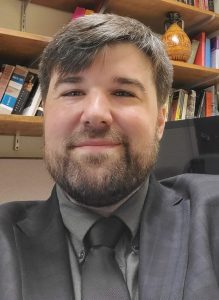About Me
I am David Thomas, an Ancient Historian and Digital Scholar. In addition to teaching at the university level, I have also worked professionally as a public school teacher and as an instructor for an intensive summer camp for gifted children. I have worked with students from middle school through college, and with varied skills, backgrounds, and challenges. As the son of two educators, teaching, whatever the subject, has been my lifelong calling.
As a word, ‘history’ means critical inquiry, not merely the past. History is active, one does not simply learn history, one does history. I endeavor to connect students to the material, allowing them to encounter it on their own terms. Research and teaching are passions which fuel each other. Teaching history as a process of investigation and inquiry makes students into researchers. Doing so also means that we regularly cross disciplinary boundaries into unfamiliar territory in pursuit of questions. Effective teachers are lifelong learners who encourage students to join them in posing questions and pursuing answers. At the same time, students force their teachers to consider new angles and fresh questions. My own research is avowedly interdisciplinary, drawing on research from the fields of ancient history, archaeology, anthropology, epigraphy, linguistics, religious studies, economics, philosophy, political science, social psychology, network theory, and others. I teach students that scholars must use every tool, theoretical or methodological, in order to develop their questions and get at the problems posed by our sources. In so doing, every student finds that they will be able to use their strengths and also confront their weaknesses.
My graduate research on the Athenian sanctuary of Eleusis in the Roman Era tackles the issues of identities, social competition, and public memory in Athens under the Roman empire by analyzing the changing patterns of associations represented in the epigraphy of Eleusis. The extra-urban sanctuary, fourteen miles distant from Athens, was a focal point for both Athenian and Roman power, and its inscriptions bear the mark of their public interaction. Beyond adding to our knowledge of Eleusis and Athens under the Roman Empire, I hope to contribute to the debate surrounding approaches to the post-Classical polis, to offer a methodological approach for studying civic memory and identities, and to suggest further digital applications.
Eleusis was a nexus of interaction, played out over hundreds of inscriptions, spanning centuries. Numerous institutions linked hundreds of individuals through epigraphic sponsorship and claims to office. Getting at our problem requires traditional techniques of close reading, linguistic awareness, and interpretive nuance. But, digital techniques allow us to augment these skills and untangle the complex web of interaction we find in the inscriptions, normally nearly impossible by traditional means. In my research, I use data visualization software to chart patterns of interaction and forms of representation as well as GIS and 3D modeling software to create maps and reconstruct the ideological spatiality of the epigraphic evidence.
Digital approaches have become an increasingly powerful way to approach the ancient world as well as an equally valuable means of discussing our work with the general public. Large online corpora of texts have facilitated word frequency analysis and topic modeling. Photogrammetry and 3D modeling help specialists and the general public visualize ancient landscapes. Reflectance Transformation Imaging allows anyone to view high resolution 3D images of inscriptions, and even try to read damaged inscriptions themselves by controlling the lighting. Online databases using the EpiDoc standard, such as the U.S. Epigraphy Project, put hundreds of thousands of inscriptions online, searchable by dozens of categories, increasingly in translation. Combining techniques enables scholars to contextualize our sources as never before. At the same time, responsible scholarship means treating our data with sensitivity. The wealth of new data delivered by digital methods only increases the traditional need to reflect on the methods and assumptions we bring to our interpretations.
Digital tools expand our ability to share our work with other scholars and also with the general public. My teaching and research find harmony in my digital approach to presentation. In the classroom, technology helps teachers augment lessons with visual components. Beyond treating pictures and maps as a background component, my discussions interact with images and texts, merging visual and auditory learning styles. Presentation tools allow teachers to convey information visually in combination with traditional classroom methods. Visual cues highlight themes, clearly articulate the context, and reinforce previous lessons. For the students themselves, digital tools also help them begin their own journeys, connecting them with useful resources and spurring discussions with fellow students online. Beyond merely presenting useful graphics, I believe that the field of Digital Humanities is about putting the data in the hands of the public, so that students can make their own interpretations and in so doing, sharpen their methods of historical investigation. Digital humanists employ technology in the service of the public, the very humanistic spirit of our work.
